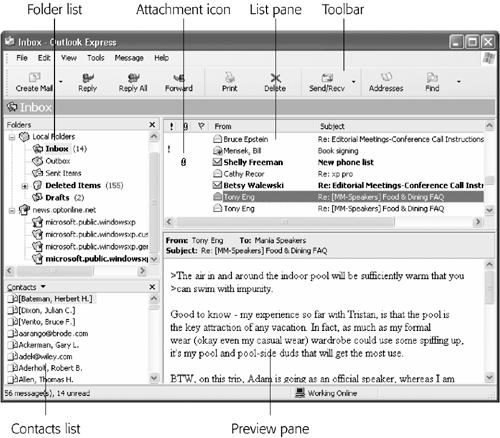Sending Email
When you finally arrive at the main Outlook Express screen, you’ve got mail; the Inbox contains a message for you. The message is a welcome from Microsoft, but it wasn’t actually transmitted over the Internet; it’s a starter message just to tease you. Fortunately, all your future mail will come via the Internet.
In order to receive and send new mail, you must use the Send & Receive command. You can trigger it in any of several ways:
Click the Send/Recv button on the toolbar. (It’s identified in Figure 12-1, which depicts Outlook Express after you’ve been living in it for a while.)

Figure 12-1. The four panes of Outlook Express. Click a folder in the upper-left pane to see its contents in the upper-right pane. When you click the name of a message in the upper-right pane, the message itself appears in the lower-right pane. Lower left: your list of MSN Messenger Service “buddies,” as described in the previous chapter.
Choose Tools→Send and Receive→Send and Receive All.
Press Ctrl+M.
Tip
Outlook Express can be set up to check your email accounts automatically according to a schedule. Just choose Tools→Options. On the General tab, you’ll see the “Check for new messages every __ minutes” checkbox, which you can change to your liking.
Get Windows XP Professional: The Missing Manual now with the O’Reilly learning platform.
O’Reilly members experience books, live events, courses curated by job role, and more from O’Reilly and nearly 200 top publishers.

